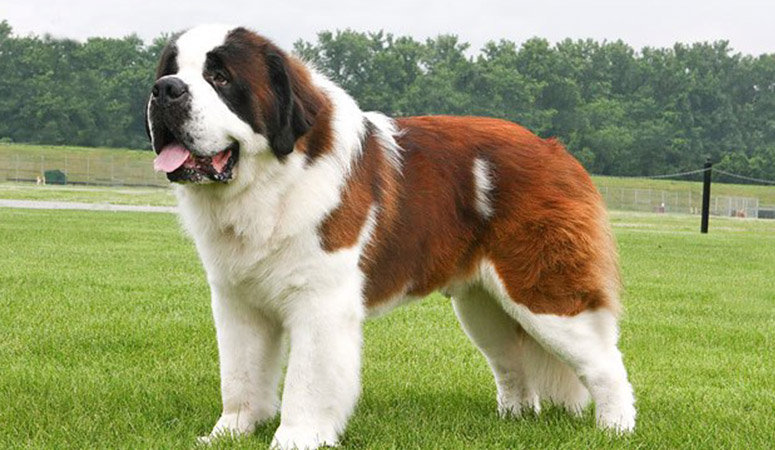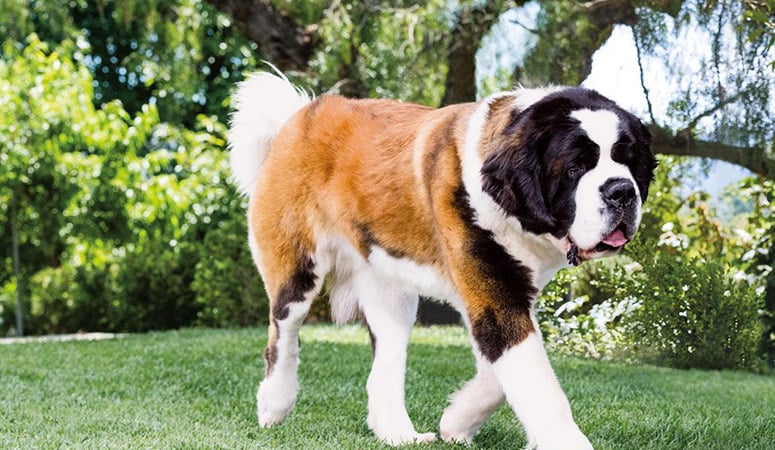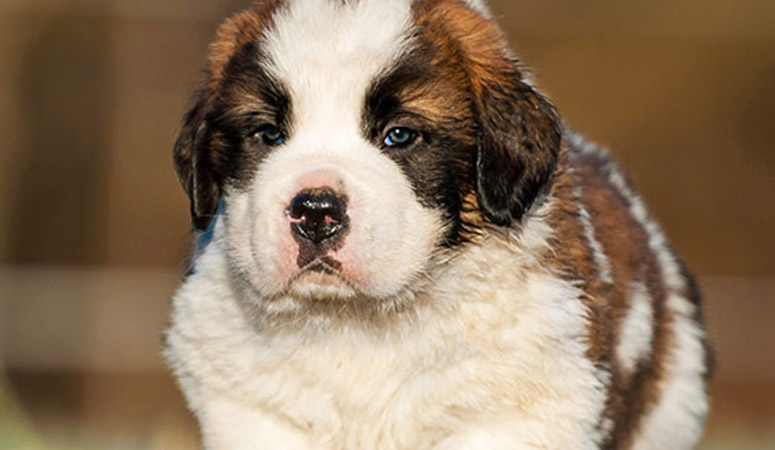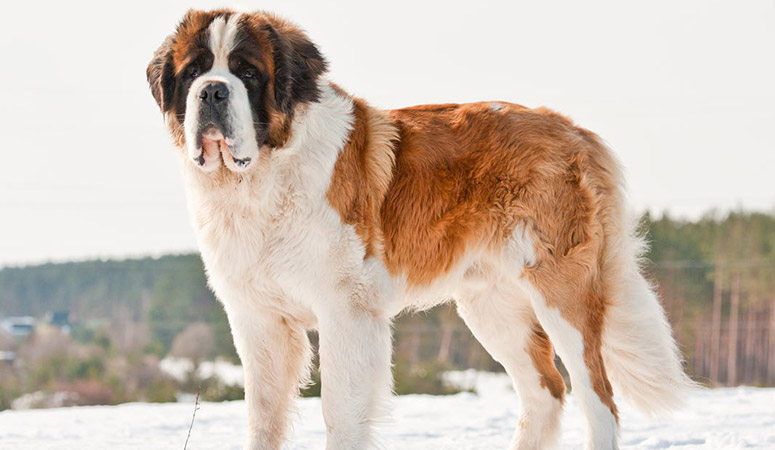Saint Bernard

Giant, bumbling, and lovable, Saint Bernard is a powerful dog but with a gentle and friendly nature. This dog breed was originally used to guard the grounds of Switzerland’s Hospice Saint Bernard and they also help find and rescue the lost travelers and skiers. Now, they are the most famous and popular dog breed all over the world.
| Other Names | Alpine Mastiff, Bernhardiner, Saint Bernard Dog, St. Bernard, St. Bernard Dog, St. Bernhardshund |
| Color | Black, Brindle, Brown, Red, Red-Brown, Tricolor |
| Height | Males: 27-36 inches. Females: 25-32 inches. |
| Weight | Males: 120-200 pounds. Females: 120-200 pounds. |
| Life Span | 8-10 years |
| Personality | Playful, Charming, Inquisitive |
| Exercise | Regular Exercise |
| Origin |
| Popularity | #48 |
| Groom Needs | Weekly |
| Kids Friendly | Yes |
| Dog Friendly | Yes with supervision |
| Watch Dog | |
| Family Dog | Yes |
| Litter Size | 8-10 |
Saint Bernard Pictures
Saint Bernard Video
Introduction
Also called the Alpine Cattle Dog, a St Bernard is a muscular and powerful dog breed with tallness that is proportionately matched to its stolid stature. They have smooth, short coats that feel rough to the touch. The coats come mainly in red or mahogany colors with shades or markings of white. St Bernard is a playful and optimistic dog breed, that sticks really close to its family members, perhaps due to its investigative nature.
St Bernard is a giant dog and as such, it is common to find a male of about 27-30 inches height when standing at the shoulder. The females are no different, only about 2 inches less. They weigh proportionately to their height, with a combination of a massive 145 -185 pounds for a standard male and 125-145 pounds for a similar female, St Bernards make an impressive figure to behold.
They are popular work dogs and can be highly energetic. They have an average lifespan of 8-10 years.
Living with Saint Bernard
Saint Bernards come in long-haired and short-haired varieties, and both types of coats need the same care. These dogs shed heavily in spring and fall, a weekly brushing year-round to keep loose hair under control. The owner needs to brush your dog several times a week with a rubber curry brush or hound glove for shorthaired coats or a pin brush for longhaired coats.
They don’t need a frequent bath, just give your dog a bath about once a week, importantly, avoid to over bath your dog, because this may deplete the natural oils in its coat.
Brush your dog’s teeth at least two or three times a week to remove tartar buildup and the bacteria that lurk inside it, the daily brush is better to keep fresh breathe and prevent gum disease. Check and gentle clean the ear once or twice a month to avoid wax and dirt buildup and to prevent infections. Trim the nails twice a month if your dog doesn’t wear them down naturally.
Although Saint Bernards are a large and powerful breed, they only need a moderate amount of exercise. A long walk or half-hour play session every day is enough to keep your dog healthy and happy. Regular exercise is a must to prevent boredom and over-excitement. More importantly, these dogs are prone to heat exhaustion and heatstroke. The owner needs to avoid letting them exercise in the heat of the day and be sure that they can always go to shade and clean water.
It is suggested that the owner should take your dog to take puppy socialization class, this could help your dog learn how to properly react to other dogs and humans.
Saint Bernard should do well on high-quality dog food that ideally is formulated for large breeds. Generally, it is recommended to feed a Saint Bernard with five to six cups of high-quality dry dog food every day, divided into two meals. More importantly, the food amount should depend on the dog’s weight, size, age, and activity level. There should be fresh and clean water at all times.
Some dogs are easy to get overweight, so you need to watch their calorie consumption and weight level all the time. Treats may be an important aid in training, but excessive intake can lead to obesity. Also, owners need to distinguish which human food is safe for dogs and which are not. If you have any problems with your dog’s weight or diet, just consult from your veterinarian.
Saint Bernards are prone to the following health conditions: Hip and elbow dysplasia, Entropion, Epilepsy, Gastric torsion, Heart disease, Osteosarcoma, osteochondritis dissecans (OCD)…
Major concerns: gastric torsion, CHD, elbow dysplasia, entropion, osteosarcoma, ectropion
Minor concerns: diabetes, OCD, cardiomyopathy, seizures, heart conditions, hot spots, CVI
Occasionally seen: distichiasis
Suggested tests:
Cardiac Exam
Elbow Evaluation
Hip Evaluation
Ophthalmologist Evaluation
Degenerative Myelopathy DNA Test
Total Annual Cost: $3536
Cost is estimated for the first year and may vary depending on many factors, such as dog food, health care, leash, collar, licensing, possible fencing, crates, training and obedience classes, dog-walking, grooming, treats, toys, flea, tick, and heart-worm meds, microchips, etc.
Saint Bernards are smart and attentive, it is recommended to start early socialization and puppy training classes for these big and strong dog breeds. They are easy to train, but the training may take longer as they stay immature longer than other breeds. The proper socialization with people and animals could prevent them from becoming wary of strangers and other dogs.
Obedience training would help Saint Bernards learn not to jump on people, steal food from the table, and knock into small children. They are enthusiastic and eager to please, so they could respond to commands as soon as they understand what is expected of them.
History
St Bernard is the national dog of Switzerland. Having a well-accounted history associated with the Great St Bernard Hospice located around Switzerland. The earliest documented evidence for the existence of this breed dates back to paintings of the 17th century. However, the ancestors of St Bernards can be traced to the century before Christ’s birth. It was believed that the Great St. Bernard Pass was an important heritage of old and monks who took abode in that region kept a good number of this kind of which was later named the St Bernard.
Earliest St Bernards had a common ancestry with Sennenhunds. They are believed to have descended from the ancient Molosser group of dog breeds. A popular St Bernard in heroic and epic proportions was a dog named Barry. Barry was reputed to have saved more than 40 lives in the Pass. A classic picture of Barry was that of a dog bearing a Brandy bottle around its neck, although some authorities dispute that. Ever since, Barry was declared a monument, and the name Barry was always given to one of the dogs of the St Bernard Hospice.
Due to the death of many St Bernards in the winters of 1814-1818, there was a drastic decline in the population of the breed, and in a bid to restore the number and create a hardier breed that could withstand climatic changes, St Bernards was crossed several times with a variety of breeds which were predominantly Newfoundlands. Owing to these multiple crosses, modern-day St Bernards seem to have diverged largely from their ancestors.
In 1884, the first breed club was founded in Basel, Switzerland. Shortly after, in 1888 a drafted standard for the breeding of St Bernards was accepted.
Helpful Information
Breed Club: SAINT BERNARD CLUB OF AMERICA
Breed Club Link: https://saintbernardclub.org/
Breed Club Rescue: Saint Bernard Rescue Foundation, Inc.
Breed Club Rescue Link: http://www.saintrescue.org/




